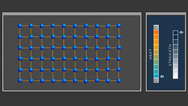The Structure of Metal
- Teacher Resource
- Posted 02.20.04
- NOVA
This interactive activity from the NOVA Web site describes the crystalline structure of metal and uses animations to illustrate the molecular changes that occur when a metallic substance is bent, heated, or otherwise changed by external forces.
Supplemental Media Available: The Structure of Metal (Interactive)


- Media Type: Interactive
- Size: 196.3 KB
- Level: Grades 6-12
-
Log in to Teachers' Domain to download, share, rate, save, and match to state standards.
Source: NOVA: "Why the Towers Fell"
This resource can be found on the NOVA: “Why the Towers Fell" Web site.
Background
Metals may be strong, but because their crystalline structure is not perfect, they can be bent, twisted, stretched, and otherwise shaped. During the cooling process, when a metal changes from a liquid to a solid state, not one but many smaller crystals form, each with imperfections. Extra layers of atoms are squeezed in at some points, while other places may be missing atoms altogether or contain atoms of a different element. These imperfections become part of the metal when it solidifies and serve to weaken the bonds between some of the layers. When an external force is applied to the metal, these layers may shift more easily than those without imperfections. Typically, when an external force is removed, the layers shift back to their original positions. If the force is large enough or repeated too frequently, however, the shifting may become permanent.
Metals are typically good thermal (heat) and electric conductors because electrons in the electron cloud move relatively freely and carry energy and electric charge as they do. Extreme heat, however, will melt metal because highly energized atoms move fast enough to break the bonds between them, thus softening the metal. The critical temperature, or melting point, is different for each type of metal.
Questions for Discussion
- What are the three main types of bonds that bind atoms together?
- What is the relationship between heat and movement of atoms in a metal?
- What are some reasons metal objects are not uniformly strong in all places?
Related Resources
-

Metal Fundamentals
Why defects make metal stronger, how hardness differs from toughness, and other marvels of this elemental substance
-

The Structure of Metal
In this interactive, explore metal at the atomic level.
-

Secrets of the Samurai Sword
Explore metal characteristics. Produce series of posters on different alloys. Outline properties and how they are used.
-

Materials That Changed History
From ceramics to steel, paper to plastics, certain basic substances have long propped up civilization.





